

Critical Thinking: A Necessary Skill in the Age of Spin. Insight. Insight is a new five-level English course for secondary students.

It is a thought-provoking course which will challenge your students to reach their full potential. Made to Stick. Made to Stick: Why Some Ideas Survive and Others Die is a book by brothers Chip and Dan Heath published by Random House on January 2, 2007.[1] The book continues the idea of "stickiness" popularized by Malcolm Gladwell in The Tipping Point, seeking to explain what makes an idea or concept memorable or interesting.
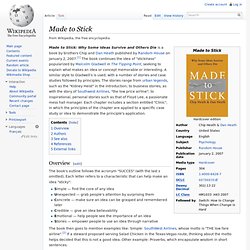
A similar style to Gladwell's is used, with a number of stories and case studies followed by principles. The stories range from urban legends, such as the "Kidney Heist" in the introduction; to business stories, as with the story of Southwest Airlines, "the low price airline"; to inspirational, personal stories such as that of Floyd Lee, a passionate mess hall manager. Each chapter includes a section entitled "Clinic", in which the principles of the chapter are applied to a specific case study or idea to demonstrate the principle's application. Overview[edit] Thinking, Fast and Slow. Conjunction fallacy. I am particularly fond of this example [the Linda problem] because I know that the [conjoint] statement is least probable, yet a little homunculus in my head continues to jump up and down, shouting at me—“but she can’t just be a bank teller; read the description.”
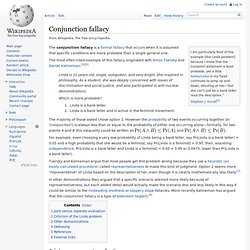
The conjunction fallacy is a formal fallacy that occurs when it is assumed that specific conditions are more probable than a single general one. The most often-cited example of this fallacy originated with Amos Tversky and Daniel Kahneman:[2][3] Save The Pacific Northwest Tree Octopus. Help Save The ENDANGERED From EXTINCTION!
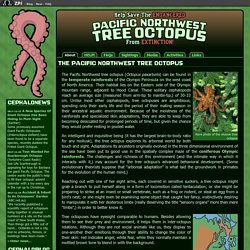
The Pacific Northwest Tree Octopus Rare photo of the elusive tree octopus The Pacific Northwest tree octopus (Octopus paxarbolis) can be found in the temperate rainforests of the Olympic Peninsula on the west coast of North America. Their habitat lies on the Eastern side of the Olympic mountain range, adjacent to Hood Canal. Center for Communicating Science.
Winner: Written CategoryNick WilliamsLivermore, California Winner: Visual CategorySteve MaguireOntario, Canada Click to see the winning entries and finalists in each category! This Year. Edutopia Webinar - How the Brain Learns Best: Strategies to Make Learning Stick. Free online tutorial for using JING. THIS IS WATER David Foster Wallace. DAVID FOSTER WALLACE, IN HIS OWN WORDS. IN MEMORIAM | September 19th 2008 The world of letters has lost a giant. We have felt nourished by the mournful graspings of sites dedicated to his memory ("He was my favourite" ~ Zadie Smith), and we grieve for the books we will never see. But perhaps the best tribute is one he wrote himself ... Special to MORE INTELLIGENT LIFE. THE MARVELS AND THE FLAWS OF INTUITIVE THINKING: Edge Master Class 2011. We ended up studying something that we call "heuristics and biases".

High School Teachers. These Thinker's Guides are available through electronic license for educational institutions.

Faculty and administrators - email cct@criticalthinking.org to inquire. This set includes the thinker’s guides which focus on the foundations of critical thinking. It also includes those guides useful in contextualizing essential critical thinking concepts and principles for classroom instruction. Resources and Downloads for Teaching Critical Thinking. Tips for downloading: PDF files can be viewed on a wide variety of platforms -- both as a browser plug-in or a stand-alone application -- with Adobe's free Acrobat Reader program.
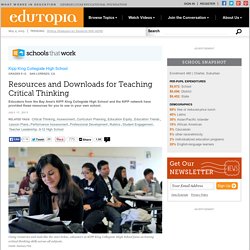
Click here to download the latest version of Adobe Reader. Click on any title link below to view or download that file. Resources On This Page: Lesson Plans & Rubrics. Ten Takeaway Tips for Teaching Critical Thinking. Suggestions from educators at KIPP King Collegiate High School on how to help develop and assess critical-thinking skills in your students.
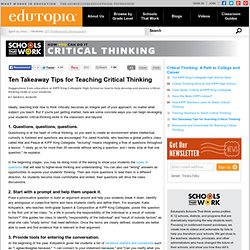
Ideally, teaching kids how to think critically becomes an integral part of your approach, no matter what subject you teach. But if you're just getting started, here are some concrete ways you can begin leveraging your students' critical-thinking skills in the classroom and beyond. 1. Questions, questions, questions. How KIPP Teachers Learn to Teach Critical Thinking. Kellan McNulty: Prior to coming to Kipp, I tried to do a fishbowl discussion and it failed.

And I had the kind of vague idea of how to do it, but I didn't have the specific tools. Three Steps to Critical Thinking. Edward Charles Francis Publius de Bono is a bona fide genius.

The author, inventor, Rhodes scholar and Nobel prize-nominated economist graduated from college at age 15. In the field of education and business, he is famous for originating the term lateral thinking. In his spare time, he also wrote Six Thinking Hats and several other books on creativity. Problem Solving. Problem-solving is an art and it can be learned. Below is Edward De Bono’s useful five-step process for problem-solving. There are however different types of problem and they require different thinking styles in order to crack them. Here are some problems to give you a bit of practice. 50_Brain_Teasers_and_Lateral_Thinking_Puzzles.